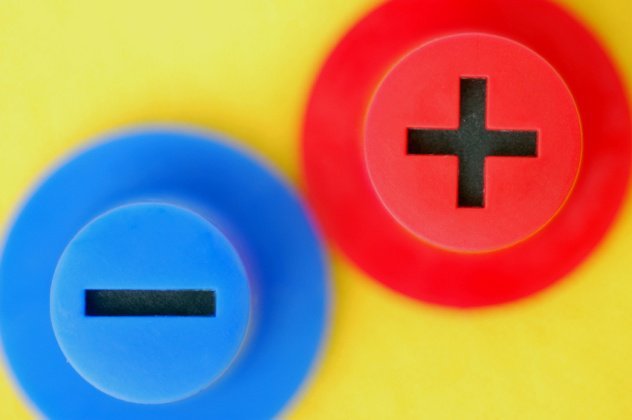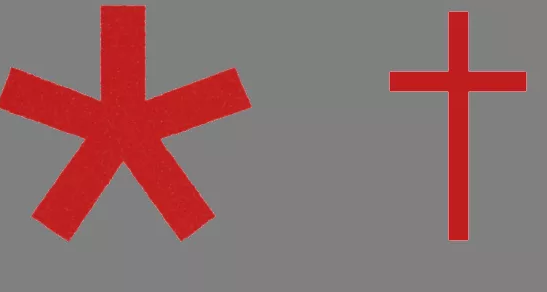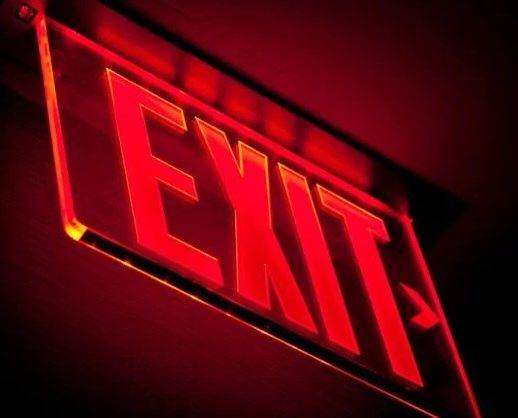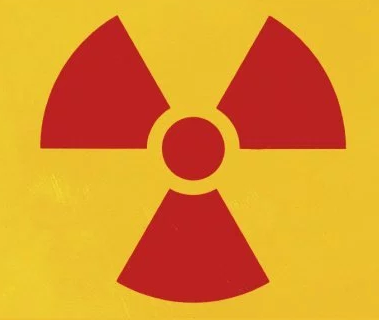(单词翻译:单击)
7.Mathematical Signs
7.数学符号
The symbols for addition and subtraction first emerged in the 15th century. The "+" sign seems to have been one of many ways that the Latin word et, meaning "and," was abbreviated.
"+"和"—"出现于15世纪。有一种说法认为"+"是拉丁文"et"的简写,意为"和,加"。
The ancient Greeks had used the letter "psi" for addition (or sometimes simply juxtaposition), while the Hindus used the word yu, and the ancient Egyptians used a pair of legs walking forward to denote addition or walking away to denote subtraction.
古希腊用"psi"表示"加"(有时表并列),印度教徒用"yu"表示加,而古埃及人用双腿前行表示加,走开表示减。
Early 15th-century Europeans were using the letters "p" and "m" for "plus" and "minus" (then called "piu" and "memo"), but the first use of "+" to mean et was probably by the astronomer Nicole d'Oresme in the 14th century.
15世纪早期,欧洲人使用"plus"(加)和"minus"(减)的首字母"p"和"m"表示加减,称为"piu"和"memo"。不过,首先用"+"表示"加"的应该是14世纪的天文学家尼科尔·德·奥雷斯姆。
The "–" sign may have originated from merchants' notation when cargo was unloaded from ships, or it may have simply have been a shorthand way of denoting the letter "m," which often had a line over it when indicating subtraction.
"—"最初可能是被商人用作卸货下船的标志,也可能是字母"m"的缩写,因为"m"表示"减"时,上方经常会画一条横线。

Interestingly, the modern division sign was originally used to denote subtraction by northern European mathematicians and may have originated from notation used on manuscripts to mark passages suspected of being corrupt or incorrect.
有趣的是,现在使用的除号早期被北欧数学家用来表示"减",可能是源于手稿中标记错误的符号。
It wasn't until the late 16th century that these symbols were commonly used in mathematics.
直到16世纪晚期,这些符号才普遍应用于数学领域。
Johann Widman and Vander Hoecke, two 15th-century mathematicians, used them.
15世纪时,数学家约翰·韦德曼和范德·赫克最先使用"+""—"符号。
They were apparently introduced into English notation by Robert Recorde in 1557, who said, "There be other 2 signes in often use of which the first is made thus + and betokeneth more: the other is thus made — and betokeneth lesse."
1557年,罗伯特·雷克德将符号传入英国,他说"有两个常用符号,第一个是‘+',表示增多,第二个是‘—',表示减少。"
6.Asterisk And Dagger
6.星号和剑标
Now exceedingly more popular due to its usage on the Internet, the asterisk was once much more rarely seen and was associated with a subordinate symbol known as the dagger.
如今星号在网络中及其常见,但以前星号并不常见,且常和剑标一起出现。
Both were traditionally used in footnotes, indicated dates of birth and death in European typography, and also indicated long and short pauses in Gregorian chant notation.
这两个符号在欧洲印刷体中作为脚注,表示出生和死亡日期,在格里高列圣咏乐谱中表示停顿的长短。
Some claim that the ultimate origins of the asterisk can be traced back 5,000 years to ancient Sumeria, where the cuneiform symbol dingir or an represented "heaven" or "divinity," Others, however, consider this connection dubious at best.
一些人称,星号的使用起源于5000年前的古苏美尔,那里的楔形文字"dingir"和"an"表示"天堂"或"神"。但很多人质疑这种说法。
More reliable history ties the asterisk and dagger to the Library of Alexandria, which was attached to a larger center of learning called the Mouseion.
较为可信的说法是,星号和剑标与亚历山大图书馆有关,而亚历山大图书馆又附属于亚历山大学宫。
At the time, an Athenian official named Peisistratus had offered to pay by the line for Homeric verse, much of which had been lost. Much of what was submitted was fraudulent Homer invented by hucksters.
当时,雅典僭主庇西特拉图下令编订《荷马史诗》,因其大部分内容遗失,而当时呈交的大部分内容都是小商贩虚构出来的荷马。

A grammarian at the Mouseion named Zenodotus of Ephesus was in charge of reviewing the body of work and removing fake verses, which he annotated with a single line in the margin.
来自以弗所的文法学家泽诺多托斯负责审编主要内容,将伪造篇章剔除,并在空白处划线标记。
Zenodotus's line was named "obelus," Greek for "roasting spit," which would later evolve into the dagger symbol.
泽诺多托斯所画的线称为"短剑号",后演变为剑标符号。
The asterisk came later, invented by another Alexandrian scholar, Aristarchus of Samothrace, who was charged with editing Zenodotus's work.
之后,来自萨莫色雷斯岛的阿利斯塔克发明了星号标志,他是亚历山大博物馆的另一位学者,负责修订泽诺多托斯审编的著作。
He invented several new symbols, such as the simple angled diple to mark noteworthy passages and the spotted diple, which marked passages over which he disagreed with Zenodotus.
他发明了几个新的符号,比如">",用来标注值得一读的段落,以及点,表示与泽诺多托斯意见不同之处。
He paired the obelus with a star-like glyph he called asterikos, or "little star," which denoted passages which had been mistakenly duplicated or misplaced.
他将剑标与星形符号(称为"星号"或"小星星")结合使用,表示抄错或错位的段落。
These symbols would also be adopted by the early Christians, particularly Origen, who used variations on the symbols when trying to reconcile the original Hebrew Old Testament, or Pentateuch, with the first Greek translation.
早期基督徒沿用了这些符号。奥利金将这些符号加以修改,用于核对希伯来语旧约圣经或摩西五经与希腊译本。
Various permutations of these symbols would be passed down throughout Christian scholarship, though their precise shape and meaning shifted and evolved over time.
这些符号的排列形式经基督教学者流传后世,具体的形状和含义也随时间不断变化。
5.Exit Signs
5.安全出口标志
There are two major competing standards for exit signs in use around the world. The United States uses the word "EXIT" in bold, red type, which is considered appropriate for its high visibility and bombastic nature, using a color usually associated with danger.
世界上主要有两种安全出口标志,美国用粗体的红色"EXIT"表示,这种标志字体大,醒目,且一般红色表示危险。
However, much of the rest of the world uses a pictogram of a running man leaving through a door in green, which is readily understandable to people of any language and background and uses a color traditionally associated with safety.
然而,其他国家都使用象形符号,标志上是一个跑着通过绿门的人,绿色通常让人联想到安全,这对所有国家的人来说都很容易理解。
The US sign has its origins in the 1911 Triangle Shirtwaist Fire, in which 146 workers were killed in a Manhattan garment factory.
美国的安全出口标志,源于1911年曼哈顿一家服装工厂的火灾——三角女衣厂火灾,这场火灾夺走了146名工人的生命。

This encouraged the National Fire Protection Association (NFPA) to begin to promote the concept of "life safety," meaning the importance of getting people out of burning buildings.
这一事件促使美国消防协会推广宣传失火大楼逃生的重要性,即"生命安全"。
They developed the criteria for emergency exit signage during the 1930s and 1940s, experimenting with different sizes and stroke widths for lettering until establishing a standard.
他们在20世纪30、40年代推出紧急出口的标志,当时的字体大小和宽度多有不同,最后形成了统一标准。
According to Robert Solomon of the NFPA's Building Fire Protection and Life Safety departments, an English word was chosen over a symbol because, "The U.S. was more parochial then."
据美国消防协会建筑防火和生命安全部门的罗伯特·所罗门所说,美国之所以选择英文而不选图形,是因为"那时的美国,教区观念还比较重"。
Over the next few decades, however, graphical symbols came into vogue. A Japanese fire safety association ran a competition for a new national emergency exit sign, receiving 3,300 entries. It was won by designer Yukio Ota with his running man image, which was then tweaked and evaluated.
然而,接下来的几十年,图像开始流行。日本的一家消防安全协会举办了一场"征集国家新安全出口标识"的竞赛,收到了3300件作品,最终,太田幸夫设计的图像——"一个跑着的人"——获胜。后来,图像做了轻微调整,得到认可。
The angle of the leg was even changed because it looked like he was sprinting, and they wanted to encourage people to run slowly in an emergency situation.
他们想让身处紧急状况的人慢下来,便对图像上腿的角度也做了调整,因为之前两腿的角度像正在冲刺。
4.Radiation Symbol
4.小心辐射标志
The now universally recognized radiation symbol was first invented in 1946 by a team working at University of California at Berkeley's radiation laboratory.
现在世界通行的辐射标志,是1946年由奈尔·贾登带领的团队在加州大学伯克利辐射实验室创造的,
The team was led by Nels Garden, who was quoted as saying, "A number of people in the group took an interest in suggesting different motifs, and the one arousing the most interest was a design which was supposed to represent activity radiating from an atom."
他曾说"小组成员有很多人对创造不同图案感兴趣,最能激起队友兴趣的图案是展现原子辐射的。"
However, the actual reasons the symbol was chosen are unknown.
然而,图案入选的真正原因不明。

The theory went that if it represented an atom, then the central circle represented a radiation source, and the three blades represented alpha, beta, and gamma radiation, respectively.
关于辐射图案的来源,有人认为,如果图案代表原子,那中心的圆代表辐射源,三个叶片分别代表α,β和γ射线。
It may also have been inspired by a symbol used at the naval dry dock near Berkeley which warned against spinning propellers, or it may have been adapted from a pre-1947 radiation symbol consisting of a red dot with red lightning bolts radiating outward, similar to electrical hazard symbols.
还有人认为,伯克利附近的海军干船坞使用某种图形来警告飞机,辐射图样也许就是受了这种图形的启发。而鉴于1947年前的辐射标志为一个红点和向外辐射的闪电螺栓,类似"电气危害"的标志,现在的辐射标志也可能与此有关。
Another fringe possibility is that the symbol may have been influenced by the Japanese battle flag, which would have been familiar on the West Coast.
还有一种可能,图样受了日本战旗影响,毕竟美国西海岸对日本战旗不可谓不熟悉。


